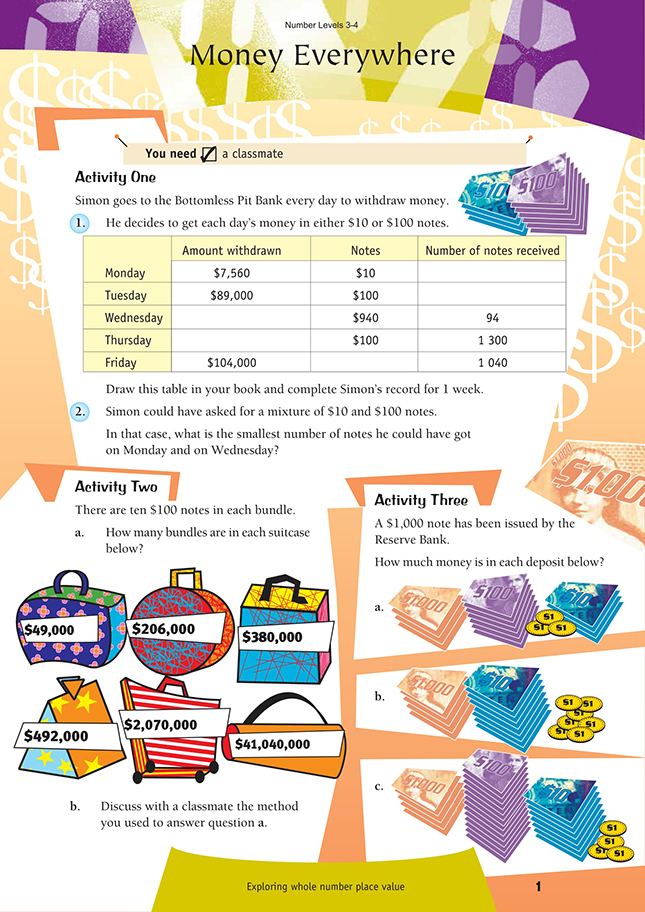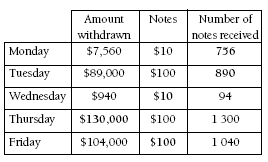This is a level 3 number activity from the Figure It Out series. It relates to Stage 6 of the Number Framework.
A PDF of the student activity is included.
Click on the image to enlarge it. Click again to close. Download PDF (474 KB)
find the number of 10s and 100s in whole numbers
FIO, Level 3-4, Number, Book 1, Money Everywhere, page 1
A classmate
The activities on this page draw on the students’ knowledge of place value and multiples of 10. It is important that they recognise and understand place value rather than just accepting a rule that involves crossing off one or two zeros. Nevertheless, the students should recognise that dividing by 10 results in crossing off a zero. The concept you need to reinforce is how many tens (or hundreds) can be formed
from the number. The underlying concept is the understanding, not rote rules.
Activity One
Ensure that the students understand what they are being asked to do. You could ask them to explain the question, for example, “For Monday, I need to find out how many 10s there are in 7 560”. From this, they may be able to rewrite the question as 7 560 ÷ 10 = and go on to solve the problem.
Again, the students need to look at the “total number of tens”, not just the number in the tens column.
Students who are having difficulty could begin by working on simpler, similar problems, such as $30 in $10 notes, $600 in $100 notes, $750 in $10 notes, $3,000 in $100 notes, and $4,500 in $100 notes. The teachers’ notes for page 8 of Number, Figure It Out, Level 3 discuss the concepts that students need to understand when dividing by 10 and 100. Some students may need to use money to help them solve the problem.
Activity Two
This activity is similar to Activity One, but here one more step is involved because the students have to find the number of bundles of notes, not just the number of notes. They may solve this by dividing the amount of money by 100 to find the number of $100 notes and then dividing the number of notes by 10 to get the number of bundles. Some students may notice that dividing by 10 and then by 100 produces the same result as dividing by 100 and then by 10. The students may also notice that a more efficient way of finding the number of bundles is to divide by 1 000. This is
because dividing a number by 100 and then by 10 is the same as dividing by 1 000 (which is 10 x 100).
Activity Three
This place value activity asks students to count the number of notes and coins of each denomination and to work out the total value.
The students can use a variety of strategies to do this. One way is to calculate the total value for each denomination and add the amounts. For example:
4 x $1,000 = $4,000
7 x $100 = $700
4 x $10 = $40
3 x $1 = $3
$4,743
Other students may recognise that the 4 goes in the thousands place, the 7 in the hundreds place, and so on. This is a more efficient method, but the students need to remember to use a zero as a place holder if there are no notes of a certain denomination. For example, in question b, they may not recognise that there are no $100 notes and therefore may omit the zero in that place in their answer. This is a very common error with students who go directly to the answer instead of performing the step in the multiplication.
Question c requires the students to find the amount when there are five $1,000 notes and another fourteen $100 notes. Here, either the students will need to recognise that the fourteen $100 notes are equivalent to another $1,000 note and four $100 notes, or they will need to multiply each denomination and add the totals.
Encourage the students to explain and compare their strategies to see if any did go directly to the solution.
Answers to Activities
Activity One
2. Monday: 81 (75 $100 notes and six $10 notes)
Wednesday: 13 (nine $100 notes and four $10 notes)
Activity Two
a. i. 49 ii. 206 iii. 380
iv. 492 v. 2 070 vi. 41 040
b. Answers will vary. You could divide by 10 and then by 100, divide by 100 and then by 10, or divide by 1 000.
Activity Three
a. $4,743
b. $5,087
c. $6,484

